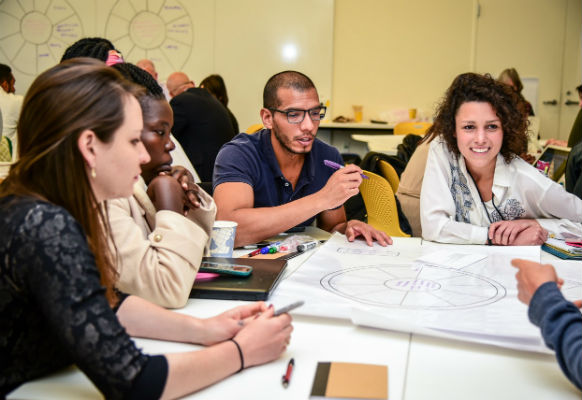Why Cultivating Your Innovation Ecosystem Is Worth the Work

Collaboration
Why Cultivating Your Innovation Ecosystem Is Worth the Work
New research shows there are clear benefits to strengthening the complex environments that enable place-based innovation.
Since Paul Bloom and Gregory Dees first urged social entrepreneurs to cultivate their ecosystem a decade ago, “ecosystem” frameworks for innovation and entrepreneurship are finally moving into mainstream economic development practice. These frameworks use the metaphor of a biological ecosystem to refer to the complex, dynamic environments in which innovators operate—environments characterized by an array of interacting organizations, individuals (collectively referred to as “actors”), elements, relationships, and conditions that either enable or impede innovation. A growing number of educators, practitioners, and donors are recognizing the importance of these environments and focusing on ecosystem-strengthening initiatives (such as this state-level initiative by Harvard and this regional one by MIT REAP), as well as efforts to map innovation ecosystems at the city level (like these maps of Boulder and Sacramento) and beyond. The Global Ecosystem Snapshot Initiative launched last month by the Aspen Network of Development Entrepreneurs (ANDE), for example, is aiming to produce a consistent set of ecosystem “snapshots” across 48 countries over the next several years.

MIT D-Lab Innovation Ecosystem Builders Fellows and Scale-Up Fellows at a convening in April, 2018. (Photo courtesy of MIT D-Lab)
However, despite the recognition of their importance for economic development, the concept of local innovation ecosystems remains fuzzy. Most research informing our understanding of them focuses on concepts that are related but distinct, such as work on entrepreneurial ecosystems and local innovation systems. And while these two concepts have been in use for over a decade, they are still defined in unclear (and at times contradictory) ways, leading to different models of what these systems contain, how they function, and why they matter.
This can make it challenging for practitioners working on ecosystem-strengthening initiatives—particularly outside of existing innovation hubs—to articulate the value of their work and to engage the collaborators whose participation they need. As one organizer of an initiative in East Africa told me at the MIT D-Lab’s recent Innovation Ecosystem Builders Fellows convening, “In my city, the organizations it makes sense for us to be working with on this see each other as competitors for the same sources of funding and don’t seem interested in collaboration, even when they’re working towards the same goals.”
Another entrepreneur working on a similar initiative in southern Mexico put it like this: “Everyone is so busy just trying to get their project, organization, or business to survive. And they wonder, why should I take time away from my work to focus on a joint initiative? [This is] especially because an innovation ecosystem is an unfamiliar concept, and it’s not clear how working together to strengthen it will benefit them or the organizations and communities they care about. And the truth is, I’m not sure what to tell them.”
The benefits of stronger innovation ecosystems
To provide fellows with more clarity on these issues, the Local Innovation research group at MIT D-Lab has been conducting research on local innovation ecosystems, which we define as “place-based communities of interacting actors engaged in producing innovation and supporting processes of innovation, along with the infrastructure and enabling environment which allows them to create, adopt, and spread solutions to local challenges.”
To date, we have looked at the development of local innovation ecosystems in a wide variety of contexts, including rural fishing and farming communities in Zambia and the Philippines, as well as mid-sized North American, South American, and African cities. Across these different contexts, we have found that developing a local innovation ecosystem—or strengthening one that already exists—produces a consistent set of benefits for local innovators, entrepreneurs, and localities, including:
- Common assets, including physical assets such as workshop and co-working spaces and financial assets like new savings and loan funds for innovators
- Shared infrastructure, including communication infrastructure and “relationship infrastructure,” such as new networks and linkages between members of the system
- New resources, including information, new know-how, and a workforce with enhanced skills specific to certain industry and innovation niches
- Favorable operating conditions for local innovation, including changes in norms, rules, and policies to create a more-level playing field
- New capacities within the system—such as large-scale production, distribution, and collective action capacities that enable coalitions to achieve results that no single member of the ecosystem could have achieved on its own
An innovation ecosystem-strengthening initiative in the Visayas-Mindanao region of the Philippines, led by the CGIAR Research Program on Aquatic Agricultural Systems, illustrates these benefits. The effort brought together local farmers, university researchers, and government officials to jointly address a major economic crisis in the region: the destruction of the area’s main export crop, abaca, due to a plant virus. Over the course of two years, the members of the initiative developed a new source of virus-free abaca seedlings and a novel distribution mechanism to ensure that farmers had equitable access to the seedlings. It also fostered new, farmer-led working groups that developed and spread technical know-how on abaca rehabilitation protocols, and a regional coalition that strengthened relationships among members of the system and resulted in new sources of government funding for the abaca work.
Fundamental to the success of the initiative, as documented in this paper, was “a shift and improvement in the dynamics of the relationships—from suspicion to greater mutual appreciation, and from a competitive stance to a climate in which partners were voluntarily contributing funds from their own budgets to support a common agenda.”
Strategies for engaging collaborators
So how did they do it? How did they—and others we have studied—enlist a diverse array of actors in their efforts and keep them contributing to ecosystem-building efforts over time? Across cultures and types of innovation ecosystems we researched, ecosystem-builders highlighted five engagement strategies that contributed to their success:
- Identify a “shared dream.” The ecosystem-builders we studied started by identifying individuals and organizations who played pivotal roles in their ecosystem, whether or not they self-identified as “ecosystem actors.” They then identified a “shared dream” that united these various actors—often this was a high-priority challenge or opportunity participants could directly relate to, even if it wasn’t the main focus or mission of their organizations.
- Start with the motivated champions. Ecosystem-builders started by connecting the most motivated and active members in their local systems—people equally passionate about the shared dream and already taking some steps toward it, though often without awareness of others’ work. The first steps involved connecting these leaders with each other and providing regular opportunities for them to develop relationships, learn from each other, and identify common barriers and opportunities in their work.
- Build from small wins. The next step was to identify what was already working in their system and what specific barriers these efforts were facing. Ecosystem-builders worked jointly with others on addressing those challenges, focusing first on practical, technical challenges where “small wins” were possible. These initial successes cleared the way for initiatives to gain momentum, and to build trust and comradery among those engaged in the effort. They also built participants’ confidence and skills to tackle more complex challenges; for example, moving from developing a technique for salting and preserving fish to mechanisms for co-managing shrinking fish stock more sustainably.
- Create safe spaces for joint learning. Successful ecosystem-building initiatives focused on creating opportunities for participants to gain skills and knowledge through peer learning and small, experimental projects designed to build hands-on practice (“learning by doing”). In the case of abaca rehabilitation, farmers learned how to identify and eradicate the virus hosts, while in a case in Philadelphia, business owners learned how to incorporate money-saving sustainability practices into their operations. Importantly, these learning experiences were facilitated by a trusted, “neutral” convener who could create what participants felt were “safe spaces” for making mistakes, engaging in trial and error, sharing doubts and challenges, resolving disagreements, and, ultimately, learning jointly with each other.
Through these five strategies as well as context-specific ones, the ecosystem-builders we studied succeeded in engaging the allies they needed to create local environments that were more conducive both to the emergence and success of local innovations, and to the adoption and adaptation of innovations from elsewhere. And despite the time and effort these initiatives required, they have enabled their participants not only to achieve high-priority individual and organizational goals, but also to achieve ambitious regional, system-level goals no single member of the ecosystem could have achieved alone.
